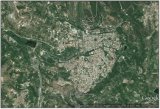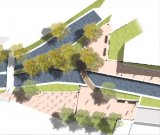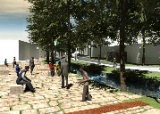E-CLIC Case Study #7
Edessa
1. Description and context; a brief introduction
“Edessa. An urban study of Green Infrastructure” was promoted and funded by the Thiseas and NSRF (National Strategic Development Framework) programmes, and aims to introduce a landscape environmental strategy, to improve standards of living and to attract visitors. The landscape masterplan focused on the creation of three continuous walks along Edessa’s waterways, which reintroduce history, culture and nature,and reconnect them to the local urban context. This has been achieved by carrying out an extensive analysis of the physical, cultural elements and meanings of places, and by encouraging the access and participation of local people with the proposed connection of waterways and green spaces. The principles of the ELC are implemented throughout the design and construction phases of the project.
2. Country
Greece
3. Location
Edessa
4. Year
2013
5. Landscape Type
Urban
6. Policy associated with (please note if this project is part of a wider sustainable development strategic and political framework)
This project is part of a proposed green network development strategy for the city of Edessa, which unifies the landscape and promotes sustainable design. It is included in the actions for “Environmental Infrastructure”.
7. Policy target associated with the implementation of the project:
7.1 Type of target
Planning
7.2 Description of the concrete targets
This strategy aims to enhance and protect the environmental and ecological aspects of the area, to care for the civilization and societal needs, and to improve economic conditions. In line with these goals, the Masterplan provided solutions about the maintenance of indigenous plants and animal species, the protection of biodiversity and waterways, the accessibility and connection of recreational areas, the increase of commercial activities/ income, and development of sustainable tourism.
8. Implementing agents
8.1 Main actors involved
The Masterplan was commissioned by the Municipality of Edessa and the Region of Macedonia. The project was developed by the Laboratory of Floriculture & Landscape Architecture, School of Agriculture, Aristotle University of Thessaloniki (Design team: Dr.I.A.Tsalikidis, M. Lionatou, F. Papapetrou, M. Goutziamanis), the Municipality of Edessa (Dimitris Metaxas) and the Edessa Development Company.
8.2 Funding
National Programme Thiseas, NSRF (National Strategic Development Framework), €9,000,000.
8.3 Public participation
Public consultation was undertaken throughout the design process.
9. Contributions to the specific measures proposed by the ELC
Awareness Raising
10. The challenge
The challenge is to regenerate this particular landscape by a rational management of the control zones of public spaces, and the protection of the natural environment, to achieve the reintegration of waterways into the urban landscape of Edessa. Τhe main objective of the Masterplan is to introduce a landscape design strategy for the waterways and green spaces of the city of Edessa. This objective delivers to Article 5 of the general measures of the ELC.
11. The solution
11.1 Measures and actions proposed to address the project challenges
The masterplan uses the old pathways/traces (canals, green corridors) of the existing natural landscape in the redesign of the city’s three main waterways, and their connections with public spaces. Canal A is devoted to Art and Culture. The main goal of the design was to create a journey along the particular walkways which promotes the cultural and artistic character of the city. This was achieved by a mix of modern and traditional installations and by involving local artists in the creation of modern art sited at focal points along the route.
Canal B is devoted to nature. The main goal of the design was to create a new linear urban park which will celebrate the natural richness and beauty of the area. Activities of recreation and education are enhanced along the walkway. This was achieved by preserving the existing natural character of the canal and by replacing the existing hard materials (asphalt, cement) with local granite and environmental friendly materials, to minimize theimpact of the city of Edessa.
Canal C is devoted to history. The main goal of the design was to create a walkway equipped with a series of exhibition points and installations, which will display the history of Edessa (the city in the water). This route will reach the waterfalls of Edessa, which are very important historical landmarks. The dynamism of the water runs throughout the design. This was achieved by preserving the existing natural character of the canal and by creating flowing design lines along the route of the canal or of the equipment (e.g. waving metal railings).
Canal B is devoted to nature. The main goal of the design was to create a new linear urban park which will celebrate the natural richness and beauty of the area. Activities of recreation and education are enhanced along the walkway. This was achieved by preserving the existing natural character of the canal and by replacing the existing hard materials (asphalt, cement) with local granite and environmental friendly materials, to minimize theimpact of the city of Edessa.
Canal C is devoted to history. The main goal of the design was to create a walkway equipped with a series of exhibition points and installations, which will display the history of Edessa (the city in the water). This route will reach the waterfalls of Edessa, which are very important historical landmarks. The dynamism of the water runs throughout the design. This was achieved by preserving the existing natural character of the canal and by creating flowing design lines along the route of the canal or of the equipment (e.g. waving metal railings).
11.2 Degree of success in achieving the challenges
The project has been constructed and achieved its goals, with involvement of local communities in the design, revisions and approval of the project.
11.3 Main factors in the consecution of proposed objectives
The productive involvement of local people throughout the processes of project planning and implementation.
12. Methodology proposed to reach the expected solution
12.1 Instruments used
Initially, the history and geography of the area was analyzed with the aid of maps, field works. In this phase, well designed examples of parks and public spaces were listed. The outcome was a landscape assessment model which was presented through maps and tables. After its evaluation, the planning of waterways and green spaces for the city of Edessa was completed.
12.2 Participation process involved
To enhance the awareness of local stakeholders, the design proposal was presented to citizens, local authorities public and private sectors, with discussion regarding advantages and disadvantages.
13. Lessons learnt
During the consultation phase many issues of acceptance of the proposed landscape planning of natural resources were aired, since this was undermining the commercial world (e.g. by moving shops, pedestrian walkways, parking bans, etc.).Furthermore, the implementation and management of a new planning model based on sustainable planning raised doubts and questions as to whether society is ready to change behaviour, and agree to a new set of rules. However, this project fits well with the principles and concepts set out by the ELC with increasing awareness amongst civil society, private organisations, and public authorities of the value of landscapes, and through the active participations of the interested parties helping towards the identification and assessment of landscapes.
14. Key References
Baschak,L.A. & Brown,R.D. (1995) An ecological framework for the planning, design and management of urban river greenways. Landscape and Urban Planning, 33(1-3) pp 211-225
Gobster, P.H. &Westphal, L.M.(2004) The human dimensions of urban greenways: planning for recreation and related experiences. Landscape and Urban Planning,68(2-3), pp 147-165
Magazine of Region of Central Macedonia (2008)“Innovative ideas” www.inews.gr/96/anaplasi-potamovrachionon-stin-edessa.htm
Platt, R.H. (2004) Toward ecological Cities: Adapting to the 21st century metropolis. Environment, 46, 5, pp10-27.
Gobster, P.H. &Westphal, L.M.(2004) The human dimensions of urban greenways: planning for recreation and related experiences. Landscape and Urban Planning,68(2-3), pp 147-165
Magazine of Region of Central Macedonia (2008)“Innovative ideas” www.inews.gr/96/anaplasi-potamovrachionon-stin-edessa.htm
Platt, R.H. (2004) Toward ecological Cities: Adapting to the 21st century metropolis. Environment, 46, 5, pp10-27.










